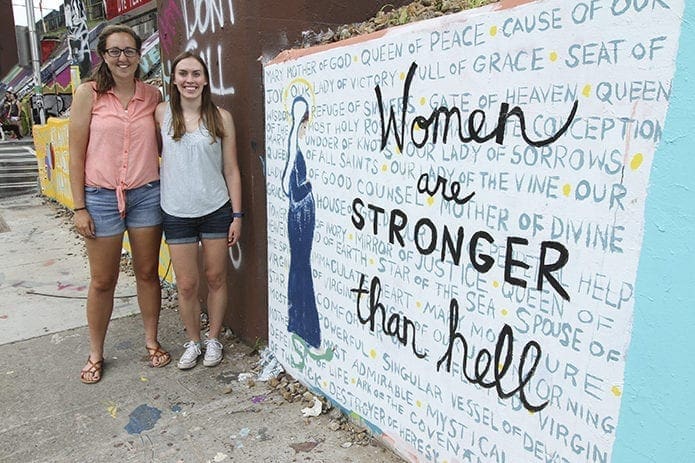 Photo By Michael Alexander
Photo By Michael AlexanderAtlanta
Reporter’s favorite story combines art and faith
By ANDREW NELSON, Staff Writer | Published January 10, 2019
ATLANTA—The image first popped up in my Twitter feed. It was a painting of a cloaked pregnant woman, twinned with a large catchphrase written in cursive: “Woman are stronger than hell.” The mural was painted on a wall at the Krog Street tunnel, one of Atlanta’s most famous outposts for public art.
I’d call it guerrilla evangelization at its finest, a scrappy way to highlight faith in a place you wouldn’t go looking for it. To Catholic eyes, it was an image of Our Lady, but to thousands of drivers and people riding scooters down DeKalb Avenue, it could be seen as a response to the #Metoo movement. I knew it would be a fun story to learn about its artists. That’s why it’s one of my memorable stories for 2018.
On a hot July day, I met Kathleen Loesel and Alison Mabery at the Sweet Cheats coffee shop in the Cabbagetown neighborhood. It gave us a chance to walk to their mural. We’d return to the shop where I would learn more about these 20-something women, one a nurse, the other making her way in the film industry. They are both transplants to Atlanta.
Their story is about faith and a desire to use their God-given talents in the world. It certainly isn’t about making money. They began painting at the tunnel by haggling for cans of returned paint at a home improvement store. The depiction of the Blessed Mother was their third mural on the tunnel wall.
In plain view of everyone traveling by, they put their faith and talents out for others to judge. During the work, curious folks stopped to learn more including a Protestant pastor and his wife. The different understanding of Eucharist was obvious, but the art started a conversation, a goal all along. The pastor applauded the women for their passionate faith.
Kathleen and Alison wanted the mural to be a feminist showpiece with a Catholic perspective. Loesel’s view of a feminist is “someone who respects the dignity of every human life, whether that is male or female. It is all boils down to the respect of the person. Catholic feminism empowers the woman without degrading the man.”
St. John Paul II seemed to be writing to them when he penned a 1999 letter to the art community—“Artists of the world, may your many different paths all lead to that infinite Ocean of beauty where wonder becomes awe, exhilaration, unspeakable joy.”
Read Nelson’s piece, which included a video, on the muralists here.